This article is taken from a presentation Jacqueline Porter gave at the Product-Led Festival. Get the full talk on-demand here.
My name is Jacqueline Porter, I’m the Director of Product Management at GitLab. I learned while working at GitLab, a fully remote organization with over 1700 local employees, that one way to accomplish innovation is to create a safe haven for it.
This is done in all sorts of ways but one of them is by bringing together all different kinds of perspectives, backgrounds, and contexts into a collaborative environment. Innovation is driven by differences and realized by inclusive teams.
Here’s our main talking points:
- The impact of inclusion
- What is inclusion?
- A real-life inclusion case
- How inclusion in your product teams supports business goals
- Building inclusive teams: Tips and tricks
Let’s go ahead and dive in 👇
The data-backed impact of inclusion 📊
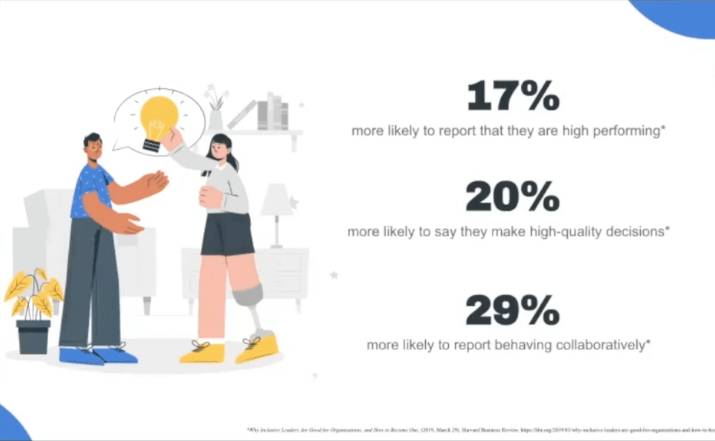
A recent Harvard Business Review article surveyed more than 4100 employees about their leadership style and inclusion. From this research 17 discrete sets of behaviors were identified in those leaders and they were grouped into six different categories or traits.
A 360-degree assessment tool for use by the employees was then developed and the instrument has been leveraged by over 303,500 raters to evaluate over 450 leaders.
The results of this assessment are particularly interesting and suggest that inclusive leaders have tangible and significant business impacts.
- First, in comparison to the respondents that do not have inclusive leaders, employees with Inclusive leaders are 17% more likely to report their teams and organizations are high performing.
- Of the survey raters with inclusive leaders, they’re 20% more likely to say their leaders and organizations also make high-quality decisions.
- Finally, in terms of culture-building with employees, those raters who said they had inclusive leaders are 29% more likely to report behaving collaboratively.
What is inclusion? 🤔
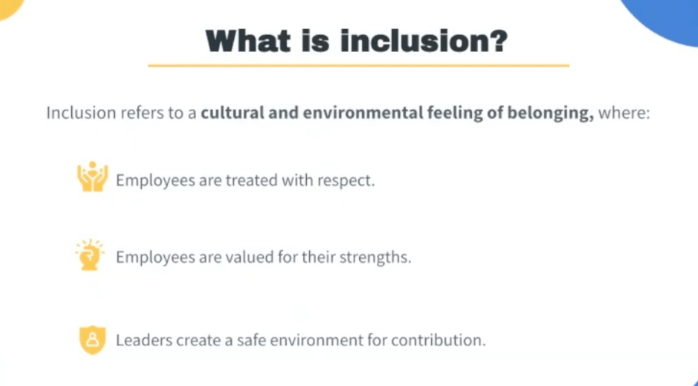
In 2018 Gallup conducted a workplace study that established many standards for building a diverse and inclusive team. There are three common threads across the body of research, which included a survey of 200 organizations as well as a literature review of all of the documentation since the 90s that occurred on inclusion.
These three themes are as follows:
- Teammates are treated and treat others with civility and decency.
- Employees simultaneously believe that they bring value to their team and they belong or that there’s a strength-based recognition of their contributions to the organization.
- There’s an inherent trust in the leadership that they’re fair and they're building a safe environment for employees to contribute.
A real-life inclusion case 👇
A story from my own experiences
A couple of years back, I was providing consulting for a leadership team in Austin, Texas. They were looking to improve their product team's business results by giving training to managers. The CEO was convinced that they weren't hitting their targets as expected because the managers of the team didn’t have the skills to lead expansive programs.
The product organization consisted of about 10 people who were all there since the beginning of the company, many of which were college friends of the CEO or even family members and connections of those family members. Needless to say, the product organization was very homogeneous in terms of background, culture and perspectives. I paused for a few moments during the first discovery call with the CEO and asked, “why are the results of the team tied to the manager's ability to lead programs?” to which he replied, “they absolutely aren't”.
I began to quickly realize the root cause of the business results not being attained by the team and the solution the organization was asking for were not congruent so I asked the CEO some follow-up questions. “Are your business goals and company results transparent to your organization?” he replied, “yes, we have weekly all-hands with the company, roadmaps are published on an intranet, and teams can access our business goals and progress at any time via the goal tracking software we use”. Transparency is a good item to have to understand where everyone's going.
My second question was: “does your team look at the market landscape and competitive position when creating the roadmap?”. This is when the CEO went on a 15-minute soapbox about how robust their competitive review process was and how they included analyst calls inside of their product roadmapping experience. They're not achieving results because a competitor is clearly moving in a direction they aren't so that was good to hear.
My third question was: “is the product roadmap reviewed by the company or any other subject matter experts, before committing to that roadmap?”. The CEO was silent for about a minute and a half and then all of a sudden, he looked like he had a lightbulb moment and explained that the roadmap is decided by the executive leadership team and then handed off to the product managers for execution and verification. He never realized that even though feedback was something that happened organically throughout the roadmap creation process amongst the executives, he never shopped it around to the organization or other subject matter experts before executing against it.
The last question I asked was: “when feedback is provided on business goals or company targets, how do you go about including that in the product direction?”. The CEO laughed and said he actually just thanks people and does not think to revisit the business goals in light of the feedback. I was astonished when I heard this but I did reply to him, “do you think you're creating an environment of innovation if people's perspectives aren't included in the decision-making?” he nodded and agreed that his approach for incorporating feedback could definitely be improved.
After doing some more discovery, the CEO ended up changing my consulting project from this training for managers to implementing a product feedback and strategy review process within the organization.
A year after implementing this process, the business results that were tracked by the company which was primarily revenue generation, improved by 20%. That's a huge number.
Learnings & takeaways from the story
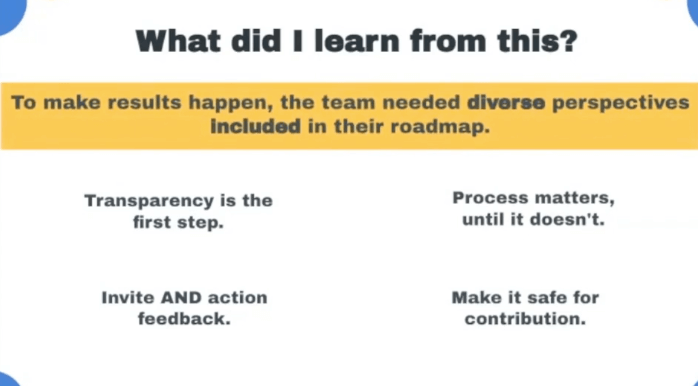
The CEO had some great things in their company and upon reflection of this experience, they had a great opportunity to showcase some of their learnings.
The leadership had a single source of truth for their product roadmap. This meant that all teammates understood the value they were expected to drive, what they were bringing to the organization and how to contribute meaningfully to that organization. This transparency was the first step to building a shared understanding of the organization.
There were great processes around the market landscape and product operations. For example, they had established best practices and documented standards for how to work effectively as a product management organization.
Although, they had one process that took away from the opportunity to innovate and incorporate new learnings and different perspectives, which was the fact that leadership handed down the product strategy and roadmap for execution, rather than it being built by domain experts or the product management team.
This meant there was little to no opportunity for challenging or improving the direction of the company. It was the same decision-makers driving the strategy year after year. Altogether, a huge takeaway is that if you have the wrong process, you can truly stifle the innovation and inclusivity you're trying to drive as a product organization.
The most surprising learning from this consulting opportunity was that feedback can be encouraged but never acted on by the organization or leadership. People are far more likely to feel committed to a cause and engage in high-performing activities when they're actually a part of the solution or direction. Without implementing changes, or their suggestions, high performance and results are highly unlikely to change.
The last big learning for me is that in order to pivot away from a particular direction, there must be safety in challenging the status quo. Without that, people will be unlikely to feel like they can actually make an impact. This is especially true if the feedback is collected and no action is taken.
It's also a risk if the decision-makers are the only producers of the product roadmap and direction or strategy. Psychological safety goes a long way in supporting innovation and smart risk-taking in your organization.
To make results happen, the team needed to have diverse perspectives included in their roadmap.
How inclusion in your product teams supports business goals 🎯
“We will all profit from a more diverse, inclusive society, understanding, accommodating, even celebrating our differences, while pulling together for the common good.” - Ruth Bader Ginsburg, addressing the profit inclusion and diversity will bring to our society and businesses.
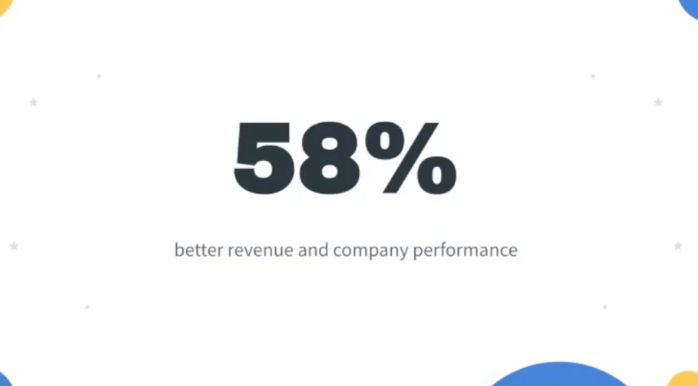
According to a 2020 McKinsey Report, when organizations have above-average diversity and employee engagement, they outperform other-like companies with less than average diversity by 58%.

To further the case of building a culture of diversity inclusion, in a study by the American Sociological Review, a national sample of 500 US-based for-profit businesses were analyzed by comparing business performance, like customer counts and sales revenue with racial and gender diversity of the organization.
In the regression model, diversity accounts for roughly 6% of the variance and sales revenue. For organizations with high diversity, they brought in nearly 15 times more sales revenue on average, than those with the lowest levels of racial and gender diversity.
Building inclusive teams: Tips and tricks 💡
Transparency
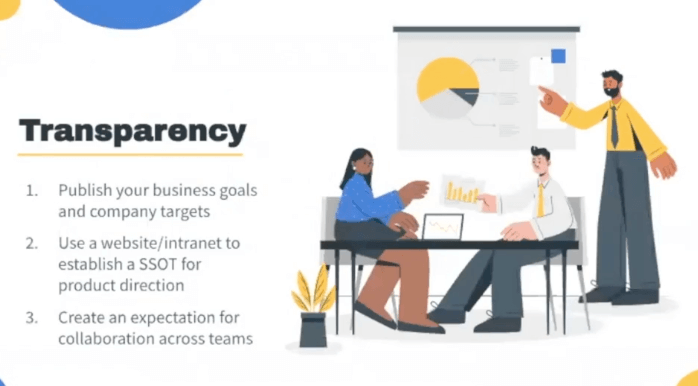
Transparency has been an ultimate game-changer for product organizations that drives true velocity and innovation. GitLab also uses OKRs and data as a method for making decisions. With OKRs and key performance indicators, you measure what matters and you share with your team what matters. Transparency is the first step for exactly how you build inclusion.
Democratizing information empowers your teammates to contribute directly to the business. For product managers in particular, alignment in the roadmap is critical. One way to accomplish this information radiator product strategy across your teams is to establish a single source of truth (SSOT) for product direction as this connects back to business targets or results will help your team fluidly execute on your strategy.
Lastly, with information being available and everyone understanding what results teams are trying to accomplish, there must be an expectation for the process of how you expect these different departments and business units to work together. This is an essential piece in order to effectively leverage the power of inclusive teams. If they don't collaborate, there's no sharing of perspectives to drive that innovation.
These three points underpin how you can create transparency in your organization. Transparency is just one of the parts, in order to capitalize on it effectively, there needs to be a continuous feedback loop between end-users, customers, teammates and leaders.
Feedback
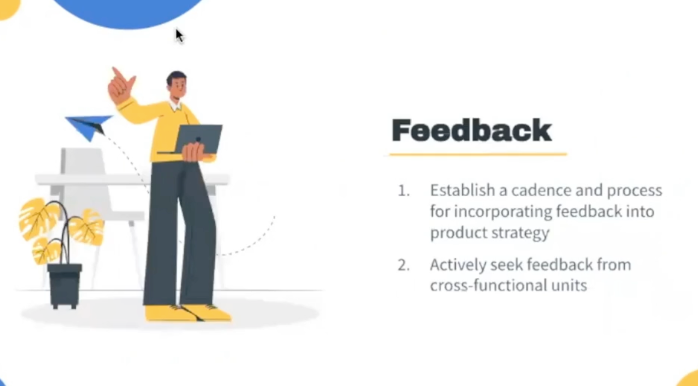
Feedback is often the most challenging system and process to establish for your teams. For those who have a practice in place for stakeholders to provide feedback on the product strategy, they often see a return and product-market fit.
Some market-facing examples for creating feedback loops include establishing a customer advisory board or incorporating prospect learnings into your product strategy and even looking at win/loss levers. Each of those events can happen on a quarterly cadence. Additionally, you can include annual analyst report findings about your market, your approach and your software.
Another method to incorporate different perspectives is to start within your organization and seek feedback from different pieces of the customer journey, which includes your customer success organization, professional services, different field teams, sales, and even GNA teams if your product happens to service them as an end-user. Hosting monthly sync meetings with key field stakeholders to share effective use case insights has been a particularly effective tool for me personally, to get that voice of the prospect and customer into product strategy.
In both suggestions whether market-facing or internally facing. Establishing a regular cadence for getting feedback will help build a community around your product strategy. Additionally, it can be a super cheap way to validate your existing direction or roadmap with the expectations of internal stakeholders and users.
Diversity
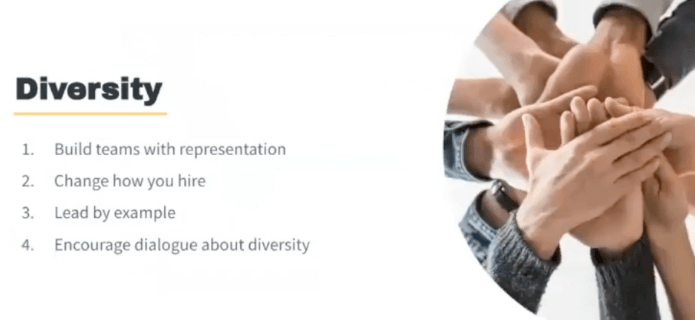
The last method is to ensure you have different perspectives on your team to inject all these different points of view. This is accomplished by building diversity.
Going back to the Gallup study, trust in the organization and leadership fairness is a foundational request to increase the sense of safety in your teams. As a part of this, increasing representation of various groups will help build that foundation. It's intentionally hiring and recruiting talent that is not only reflective of your market and consumer base but the population of the world.
In an additional Gartner 2019 report, CIOs and CEOs whose organization intentionally reflected the market they were serving saw 12% better annual performance than their competitor in the same market.
Another key component of diversity is a top-down commitment to driving diversity in your teams. This is done by leaders incorporating this focus into strategy, and company goals and coaching others on how to build teams with representation.
Lastly, a foundational requirement for psychological safety is to create a place where people can share divergent thoughts and opinions. By encouraging a dialogue on how to build diversity effectively within the organization, managers and teammates can meaningfully contribute to moving diversity forward as a business goal.
To sum up
Inclusion in your product organization is about using transparency, feedback loops, and diversity to help your employees feel like they are treated with respect, they are recognized for the strengths they bring to the organization and leaders foster an environment where questions can be asked.
Common questions
Q: When hiring to build an inclusive team, what are the must-haves you look for? How do you test for them?
A: First, I like to look for candidates that are value-driven, or mission-driven, so that I understand that they are connected to a purpose at their workplace.
The second thing I look for in teammates is action bias, so people who are driven by results and take an action based on those results handed to them.
When we think about how to test for that, the best way that I've learned is to create a diverse panel. Picking people that are not only reflective of racial, gender, and other kinds of diversity, but thought diversity, so make sure that you incorporate people from different parts of your organization to evaluate those candidates.
It's critical that as you start to look at safety and building safety in your team, you have a culture that fosters the challenge of the status quo. It’s important to look for candidates who are aligned to your values and driven to drive particular results for your company.
Q: What are the steps you're taking, both internally and externally, to create safe spaces within your teams and organization?
A: First, we offer psychological safety training for all participants that are managers or leaders in the organization. It’s required for them to complete these annually. Then, we also have a program for internal communication channels so that if people want to raise a particularly controversial idea there's a mechanism where they can report that internally.
Externally, GitLab is a huge open source community builder so we leverage an entire program around fostering community contributions and the safety there is having your standards documented in a way that everyone can have the same information available to them whenever they're contributing back to Git lab. That published standard you have empowers people to make decisions and to suggest ideas.
There's also this idea that everybody can contribute which GitLab rallies around. Particularly in the organization, I'm in right now, it makes it easy to take different kinds of perspectives and thoughts and incorporate them into product strategy. More tangibly in product strategy, we take feedback from the community, and upvotes on particular issues and those are the feedback channels we have to show we're taking the feedback from the community and building it into our product.
One of the KPIs we measure as an organization is contributions from the community. Those ended up getting prioritized and merged into our code base first, before our own features on our roadmap.
Q: What are the main forces of resistance to better inclusion and how do you overcome them?
A: In the McKinsey 2020 study, they found that change in general people's thoughts of what drives success in an organization is a huge resistance. This is where leaders who have been at a company for a long time believe there's only one way to accomplish particular results and without having somebody come in and challenge that or show that there's a different way to accomplish things, people are less likely to contribute different perspectives and innovation.
Another challenge is the idea that everyone's voice is equally weighed into product strategy. If there's not a mechanism or a standard in your organization for how you take feedback or how you incorporate ideas, then people's voices aren't considered equal and therefore are not weighed in on.
How you overcome these challenges is by challenging your leadership, which can be a difficult play. It takes a lot of openness from your leadership. Confronting that, as an individual contributor or as a leader in your organization, is about having the evidence behind your proposal to show these are going to drive results. Having a formal proposal that's connected to ROIs or benefits for the business takes the overhead of having to think if it’s going to benefit the business as a VP or an executive.
Holistically, inclusion is a systemic commitment. If the leadership and the organization is not committed to including people's ideas, that, unfortunately, is the big challenge.
Q: How do you combat unconscious biases?
A: A part of unconscious bias is that you don't know you have it until someone calls it out. The number one thing you can do in your organization is train people on how to recognize an unconscious bias. Then, instrumenting processes in your hiring would be a panel and ensuring you have representatives from different parts of your organization for racial and gender diversity. If you have a hard time finding people for your panel, there might be something wrong with the hiring practices in your organization because you're not hiring a racially, gender, and thought-diverse organization. This might solicit a proposal in order to shift the way your organization has been hiring.
Another method I found effective for challenging unconscious bias is having a rubric for evaluating candidates before you even hire candidates. If you have a stringent way of what you're looking for in a candidate, even if you don't particularly like the candidate from a personality perspective, if they check all the boxes then they're going to be the best candidate. This is a good way to standardize and not let unconscious bias come into the picture when you're interviewing candidates.



 Follow us on LinkedIn
Follow us on LinkedIn



